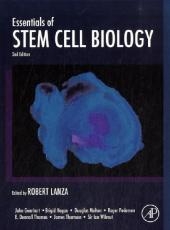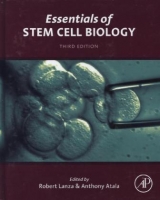
Essentials of Stem Cell Biology
Academic Press Inc (Verlag)
978-0-12-374729-7 (ISBN)
- Titel erscheint in neuer Auflage
- Artikel merken
First developed as an accessible abridgement of the successful Handbook of Stem Cells, Essentials of Stem Cell Biology serves the needs of the evolving population of scientists, researchers, practitioners and students that are embracing the latest advances in stem cells. Representing the combined effort of seven editors and more than 200 scholars and scientists whose pioneering work has defined our understanding of stem cells, this book combines the prerequisites for a general understanding of adult and embryonic stem cells with a presentation by the world's experts of the latest research information about specific organ systems. From basic biology/mechanisms, early development, ectoderm, mesoderm, endoderm, methods to application of stem cells to specific human diseases, regulation and ethics, and patient perspectives, no topic in the field of stem cells is left uncovered.
Robert Lanza is an American scientist and author whose research spans the range of natural science, from biology to theoretical physics. TIME magazine recognized him as one of the “100 Most Influential People in the World, and Prospect magazine named him one of the Top 50 “World Thinkers. He has hundreds of scientific publications and over 30 books, including definitive references in the fields of stem cells, tissue engineering, and regenerative medicine. He’s a former Fulbright Scholar and studied with polio-pioneer Jonas Salk and Nobel laureates Gerald Edelman (known for his work on the biological basis of consciousness) and Rodney Porter. He also worked closely (and co-authored papers in Science on self-awareness and symbolic communication) with noted Harvard psychologist BF Skinner. Dr. Lanza was part of the team that cloned the world’s first human embryo, the first endangered species, and published the first-ever reports of pluripotent stem cell use in humans. Sir Ian Wilmut is an embryologist who famously led the team that successfully cloned ‘Dolly the sheep’ in the mid-1990s. To achieve this technical feat, the team established a technique for transferring nuclei from adult sheep cells to unfertilized sheep eggs that had had their own nuclei removed. He now conducts research on adult cells, using techniques that avoid the need to obtain embryonic cells. Ian’s current work aims to convert skin cells into stem cells that have the ability to form all tissues. By deriving these cells from donors who have inherited degenerative diseases, it is possible to gain new understanding of how diseases arise and search for medicines that are able to prevent the degeneration. In the long run, stem cells will be used in new treatments. Ian is a strong advocate of a proposal to develop a global network of cell banks, making it possible for anyone in the world to have access to such cell therapy.
FOREWORDWhy Stem Cell Research?A New Path ?{ Induced Pluripotent Stem Cells Embryonic Stem Cells Versus Adult Stem Cells'Stemness': Definitions, Criteria and StandardsPART ONEINTRODUCTION TO STEM CELLS 1. Present Perspective and Future Challenges 2. Embryonic Stem Cells in Perspective 3. The Development of Epithelial Stem Cell Concepts4. The Advent of Direct Reprogramming 5. Clinical Translation of Stem CellsPART TWOBASIC BIOLOGY/MECHANISMS6. Molecular Basis of Pluripotency 7. Stem Cell Niches8. Mechanisms of Stem Cell Self-Renewal 9. Cell Cycle Regulators in Stem Cells 10. Epigenetic Mechanisms of Cellular Memory11. Cell Fusion and the Differentiated State12. How Cells Change Their PhenotypePART THREETISSUE AND ORGAN DEVELOPMENT13. Differentiation in Early Development 14. Primordial Germ Cells in Mouse and Human 15. Stem Cells in Extraembryonic Lineages 16. Amniotic Fluid Derived Pluripotent Cells17. Cord Blood Stem Cells18. Neurogenesis in the Vertebrate Embryo19. The Nervous System20. Neuronal Progenitors in the Adult Brain21. Sensory Epithelium of the Eye and Ear22. Epithelial Skin Stem Cells 23. The Ontogeny of the Hematopoietic System 24. Hematopoietic Stem Cells 25. Red Blood Cells26. Cell Differentiation in the Skeleton27. Vascular Progenitor Cells28. Multipotent Adult Progenitor Cells29. Mesenchymal Stem Cells30. Skeletal Muscle Stem Cells31. Stem Cells and the Regenerating Heart32. Potential of ES Cell Differentiation Culture for Vascular Biology 33. Cell Lineages and Stem Cells in the Kidney34. Adult Liver Stem Cells35. Pancreatic Stem Cells36. Stem Cells in the Gastrointestinal Tract 37. Stem Cells in the Lung PART FOURMETHODS38. Generation of Induced Pluripotent Stem Cells 39. Characteristics and Characterization of Pluripotent Stem Cells 40. Isolation and Maintenance of Murine Embryonic Stem Cells41. Isolation, Characterization, and Maintenance of Primate ES Cells 42. Approaches for Derivation and Maintenance of Human ES cells: Detailed Procedures and Alternatives43. Derivation and Differentiation of Human EG Cells44. Growth Factors & the Serum-Free Culture of Human Pluripotent Stem Cells 45. Feeder-Free Culture46. Genetic Manipulation of Human Embryonic Stem Cells47. Homologous Recombination in Human Embryonic Stem Cells48. Surface Antigen Markers 49. Lineage Marking50. Genomic Reprogramming51. Isolation and Characterization of Hematopoietic Stem Cells52. Microarray Analysis of Stem Cells and Differentiation 53. Zebrafish and Stem Cell Research PART FIVEAPPLICATIONS54. Cancer Stem Cells55. Neural Stem Cells: Therapeutic Applications in Neurodegenerative Diseases56. Spinal Cord Injury57. Use of Embryonic Stem Cells to Treat Heart Disease58. Insulin-Producing Cells Derived from Stem Cells: A Potential Treatment for Diabetes59. Burns and Skin Ulcers 978-0-12-370465-860. Stem Cells and Heart Disease61. Stem Cells for the Treatment of Muscular Dystropy62. Skin Regeneration63. Orthopaedic Applications of Stem Cells64. Embryonic Stem Cells in Tissue Engineering65. Adult Stem Cells in Tissue Engineering66. Stem Cell Gene TherapyPART SIXREGULATION AND ETHICS67. Ethical Considerations 68. Religious Considerations69. Regulatory Considerations70. It¡¦s Not About Curiosity, It¡¦s About CuresEpilogue: Concluding Statement
| Erscheint lt. Verlag | 30.7.2009 |
|---|---|
| Verlagsort | San Diego |
| Sprache | englisch |
| Maße | 216 x 276 mm |
| Gewicht | 2295 g |
| Themenwelt | Studium ► 1. Studienabschnitt (Vorklinik) ► Physiologie |
| Naturwissenschaften ► Biologie ► Genetik / Molekularbiologie | |
| Naturwissenschaften ► Biologie ► Zellbiologie | |
| ISBN-10 | 0-12-374729-5 / 0123747295 |
| ISBN-13 | 978-0-12-374729-7 / 9780123747297 |
| Zustand | Neuware |
| Haben Sie eine Frage zum Produkt? |
aus dem Bereich



